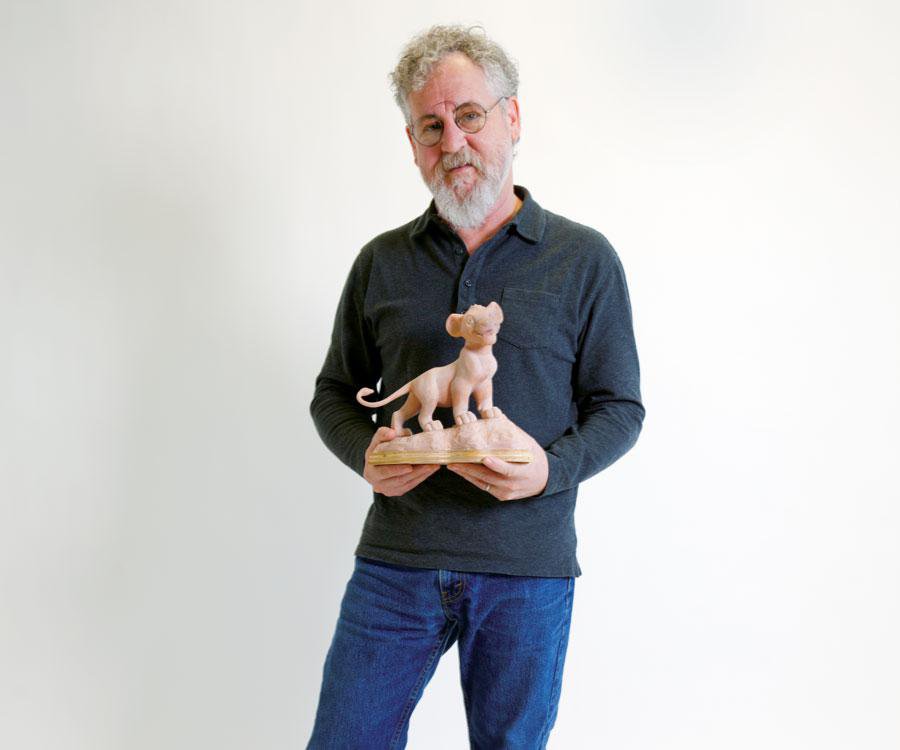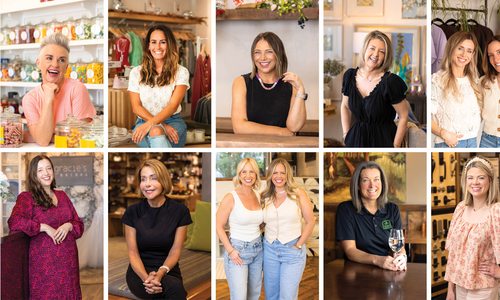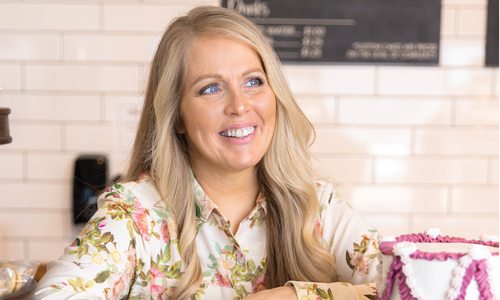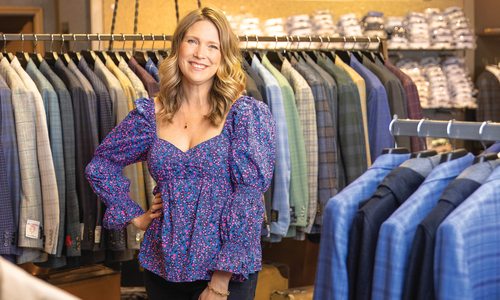Profiles
Getting to Know Kent Melton
Skill and serendipity led this lifelong artist from small-town schools with no art education to a job creating character sculptures for Disney and Pixar.
By Rose Marthis | Photos by Kevin O'Riley
Jan 2015

Kent Melton grew up in rural southwest Missouri, attending a school without art classes and fulfilling his compulsion to draw after he was done helping his father with farm chores. As an adult, he took his cartoon sculptures of the Beatles to a musical festival in Chicago. There he met a Disney employee who told him art like that could make money in Los Angeles, and through networking he was promised a job at Disney animation studios. After leaving his job carving wood at Silver Dollar City and moving his young family to Los Angeles, he arrived to a broken promise and no job. Melton soon connected with the Chicago stranger who had since moved to Hanna-Barbera studios, and Melton’s work inspired the company to hire him as its first staff sculptor. Landing a job at Disney a couple of years later, Melton helped make characters for Aladdin, Hercules, The Lion King, Tarzan, and Tangled, to name a few. At Pixar he brought The Incredibles to life, and he later created stop-motion characters for Laika Studios films Coraline and last year’s The Boxtrolls. Read how Melton’s dedication to art has created an inspiring career that is still going strong.
417 Magazine: How did you finally break into Disney?
Kent Melton: My youngest son was having his fourth birthday party. Kids were coming in, and parents would trudge in behind them. I noticed one guest just staring at my sculptures for Warner Brothers on the table. The next week, I got a phone call from Disney. It turns out the guy at the birthday party was an art director at Disney. He saw my work, and the next day he was walking past directors for Aladdin, who were talking about how they needed sculptors for macquettes. He passed on the birthday party invitation with my number on it. They called me, and as they say, the rest is history. With Disney I worked for about 16 films from Aladdin to Tangled.
417: Tells us about these macquettes and how they translate to animation.
KM: “Macquette” is a term that goes way back to the Michelangelo era that means “model of something that will transform into a larger scale.” I’ll sculpt a macquette in a character moment that personifies who they are to the story. I have to put body language into the pose to express and sum up who this guy is to the story. I try to capture their likeness and essence of personality and position in the story. From that they scan what I do and then do all other expressions and poses and repositions on the computer.
417: How does the process work? Are you building a model of a character someone else has created, or do you get to decide what the character looks like?
KM: My basic job description, if there is one, is to follow a design that a character designer has created. Basically, I am one of the first guys on the beach for the invasion of each film. I come in early in the process. I essentially get handed a blueprint. Generally, in feature films those characters are evolving and changing. Sometimes they give me really nailed-down turnaround drawings (drawings of characters from each angle), and I can sculpt from that. Other times I’ll get something scrawled out on a martini napkin. I get a lot of verbal information along with it to find out what their intention is. At Laika, they tell me that I bring a lot to the designs and kind of enhance the designs. I definitely have a big impact on what you see on the screen.
417: Do you paint the sculptures?
KM: That’s someone else’s job. I have painted them in the past. But they like me to keep moving the clay around. They don’t have me cast things or make copies of things. I like being specialized and working in animation because it’s really fascinating to see where it goes after it leaves your hand. What the painters do to it is amazing. I make it the best I think it can look when I sculpt it, but then someone will paint it, and it’s like wow! It’s coming to life. It looks amazing when they’re finished, and it makes you really proud to be a part of it.
417: What is your favorite movie to watch that you have worked on?
KM: Aladdin is one of my favorites because it was my first. I remember the experience so profoundly. I had never worked on feature film before, and I had never seen anything that I’ve done be projected on a screen the size of a house. I did the Cave of Wonders with the big tiger head that talks and moves. And that character was the first computer-animated character ever done in a feature animated film, before Pixar even. When I saw it on film I said, “It’s alive! I created this thing!” It was scanned right off of my sculpture. And it was so nice because I was just this kid who grew up on a farm, and here I am sitting in a theater with this giant character that I made happen. I haven’t experienced it since. It’s hard to pick a favorite, but that was the most profound experience.
417: Who has been most influential to work with in your career?
KM: I would say probably an animator named Marc Davis. He was one of what they call Disney’s “nine old men.” I worked with him on a porcelain line for Disney. He created Tinker Bell and Maleficent. He worked on Snow White, characters in Bambi and Cruella de Vil. He did a lot of really cool characters and was a genius. Walt Disney hired him for animation but also to design stuff for Disneyland. I got to meet with him and got to know him really well. He mentored me indirectly because I was inspired by what he did, knew his work and saw his art first-hand.
417: Why did you choose to move back to Missouri and continue your sculpting career from here, instead of living in LA?
KM: Because Missouri rules. It’s where Walt grew up. He loved it and always went back. LA is nice, but it’s a little crazy. The other thing is that as an artist there is so much to do in LA. There are so many concerts and events and gallery openings, and I was going to all of that. I found that my life was slipping by me, and I wasn’t getting anything done because I was living vicariously through others’ accomplishments. I just thought I had to go somewhere where there isn’t any distraction. So now we’re on a lake where it’s chill. And every once in a while when my wife, Martha, and I get tired of the silence we go check out Europe or something. My son still lives in LA, so I get plenty of trips anyway. I actually enjoy it more now that I don’t live there.
417: Do you have a character you love the most?
KM: That’s kind of like saying which one of your kids is your favorite. I really don’t. I really like all of them; all of them are a challenge. All of them are a joy to sculpt.

417: Go back to the beginning—what is your background and training and how you got into sculpting art for movies?
KM: Background and training is simple: I have no real training to speak of. I grew up in a rural area. My father taught agriculture and was a farm boy. I grew up in the country. Schools sometimes in rural areas didn’t have art programs, which was my case. But I always had a compulsion. My mom said I started drawing compulsory before age 2. Pretty much once I picked up a pencil, I was driven.
417: As a child, did you like to draw more realistic things, or did you get into creating your own characters?
KM: I did it all. Most artists, when they’re young, experiment with different subject matter. I was not unlike that. I always kind of knew it was a form of expression. Even as a child I knew that’s what it was even if I couldn’t put in those words. If I saw a character on television or a Norman Rockwell magazine cover I would try to emulate it. Dr. Seuss was a big influence. I had a lot of influences.
But I grew up isolated as an artist. I didn’t have anybody to bounce off of.
417: How did you find the Disney and Pixar studios, or how did they find you?
KM: It’s a long, crazy journey of how I got from there to here.
Pretty much through my whole life, I was always drawing. How I got into Disney was an interesting situation.
I used to eat my Cheerios and watch the cartoon show on Saturday mornings, and I was frustrated that they didn’t make toys of them.
Later in life, after I got married, I sculpted them just for fun and took them to a Beatles music convention in Chicago.
I met Don Doughtery who worked at Disney at that time. He said, “If you can sculpt cartoons like that, you could make money in LA.” He knew another guy who promised me a job at Disney studios. I ended up taking his advice, and I moved to LA.
At the time I had two young sons. I had been carving wood at Silver Dollar City for a living. I decided to move to LA and take advantage of the opportunity.
So we drove across the country in a moving van and called the guy who promised me a job, but he didn’t return my call. Here I am with a moving van and my family and we’re staying in a hotel. We can’t get a storage facility or anything to rent without a local address. Meanwhile, the contract on the moving van is almost ready to expire. I thought we had just enough money to drive home and forget the whole thing. We were in the hotel, about an hour from driving back, when I got a call from a renter who really wanted someone to take a house. We ended up staying.
From there, I still didn’t get any satisfaction from Disney. I called Don, who had since moved to Hanna-Barbera. He felt badly for me about what had happened at Disney. He invited me to the studio for lunch, and I took photos and drawings of wood carvings I had done in Branson. I had no formal education so I didn’t know how to apply for an art job. But I went in there and he introduced me to Joe Barbera, and he looked at the photographs of my sculptures and said, “We have a lot of guys who can draw but we’ve never had a sculptor.”
I believe he said, “Just hire the kid, we’ll figure out something to do with him.” I ended up getting hired as Hanna-Barbera’s first sculptor ever. They never did quite figure out what to do with me so I just kept busy sculpting The Flinstones and The Jetsons.
So that was my big break into the industry, at least into television. It wasn’t quite what I had hoped for. I had wanted to get into feature animation, but that didn’t happen until about two years later.
417: When you were sculpting for Hanna-Barbera, did you sculpt characters that they had already created, or were you helping them create characters?
KM: I was mostly sculpting from their library. In television animation, it’s what they call limited animation, and it doesn’t require sculptures for reference like in feature animation films.
They were kind of using me to pitch ideas to the network. For one example, they wanted to pitch a remake of the Wacky Racers. So they had me sculpt and fabricate a radio controlled racecar of Yogi Bear and his picnic basket. They took it to the networks to drive around on the table and impress the executives to buy this TV project.
I did lots of development things. I did get to design characters for Ed Grimely. I stayed a few years there.
I ended up freelancing for Warner Brothers, making the sculptures for Tiny Toons.
In the meantime for a couple of years or so, I kept dropping off job applications at Disney because I was a naïve Midwestern boy and didn’t know how you got hired. I thought if you want a job you dropped off job applications.
417: Are you still sculpting for feature films?
KM: I still do work for movies. I’ve worked for just about every studio you can name. Predominantly Disney was the main part of my career when I was raising my kids. It was a great job. At one point when I worked for Disney on feature films I was working on a porcelain collectables line as well. I was averaging a sculpture every three days for about eight years. I was really moving and grooving there for a while. I was kind of sculpting in my sleep. But it worked out for me to learn what I didn’t get a chance to learn in school. Instead of paying for an education, I was paid to learn.
I’ve also done a few things for live-action films. I worked on a Batman film with Tim Burton and Rocketeer for Disney. I worked on films and didn’t get screen credit for it; I just got compensated with more pay. It worked out well for me because I had three kids.
The only Pixar film I worked on was The Incredibles.
From there I did work for a stop-motion company called Laika, where I worked on Coraline, ParaNorman and The Boxtrolls.
417: Do you work for Laika exclusively now, or does Disney still try to call you?
KM: I’ve never had an exclusive contract with anybody. I’ve always tried to keep it open because it works to my advantage. I like to be flexible, not only for pay but for more fun and interesting projects. If you get locked in to one thing you might miss a golden opportunity.
417: Have you ever done any of your work digitally or on a computer?
KM: I haven’t. For me, I find that a computer is not quite as intuitive as clay. I have friends who sculpt in the computer and love it. But I haven’t had the need to because everyone likes what I do. I’m probably one of the few guys left in the industry who still sculpt in clay.
417: Have you always just been a sculptor or have you had other stops?
KM: Oh yeah, just today I finished an oil painting. I do paintings and sculpture for myself, and the compulsion to draw has never gone away. When you’re a kid you do things because you love to do them. I still do that with certain aspects of art. I sculpt exclusively as a career. But occasionally a studio will have me design a character, like in the film The Boxtrolls, I essentially designed the villain. I do things beyond executing a sculpture.
417: Do you work in the studio next to the designers or work at home and bring it back?
KM: I’ve done it both ways, but I like to work at studios. A lot of times it’s inspiring and nice for me to work shoulder-to-shoulder with other artists. I’ve found art to be an isolating existence. It’s kind of you just you and material. It’s nice to go to a studio, especially Laika because everyone is doing all kinds of work.
417: Is there a different approach when you are sculpting a macquette for a movie versus sculpting one to sell?
KM: I don’t sculpt anything to sell per say, but I don’t rule out the possibility. When I am sculpting a commissioned piece for a studio or individual, I really try deliver what they’re looking for emotional level. When it comes to my own art, basically it’s play time. Its intuitive. I play around with it; I don’t take it too seriously. I try to interact with the medium as much as possible. Let the clay or paint tell me what it wants and carry on a creative conversation with the art to find out where it takes me. I love the process. When I was a kid, I never kept anything. I never cared about the final work; it was just the process that I loved. I love the experience of painting, drawing, sculpting, playing music, carving—anything. That’s what art is; it’s an experience.
417: Can we get into the technical process of sculpting a little bit?
KM: I start by reading the script. I learn as much about characters as I can from reading the script. The designers will give me sample drawing. I’ll take that artwork, and I’ll blow it up to scale so it’s the same size of the sculpture. Then I bend aluminum wire into the skeleton of character, measuring straight off that artwork. Once I have this wire skeleton, I mount it to board. I take my clay and cut it into thin sheets. And if it’s a fat or heavy character, I will use aluminum foil and wrap it around the form to take up mass. After that I start adding clay and move it around and glob it on there to get the basic silhouette of the character. I’ll keep turning it around to check my proportions. The only time I measure is the first wire. Once I have the metal armature, I have that to keep me accurate. I keep moving it around until it looks right. And since I started off carving wood I still like to shave final pieces off at the end to perfect the form. I use polymer clay, and you can bake at a low temperature to protect it after it’s finished.
417: Which character have you had the most influence over?
KM: The Boxtrolls characters got to create. It was fun because I really got to put myself into it. Everything is based on a story that already exists, so I’m not creating a character from scratch, I’m just deciding how they look. It’s really gratifying to get to decide how they’re going to appear in the film. Most people don’t get to do that, so it’s really gratifying as an artist.
417: What is your mindset when you are sculpting a character?
KM: I love every character I work on. I kind of get into playing the role like an actor. I don’t ever look at one and say, “Oh, they’re ugly.” I am on their side. I am them. I bring my personal life experiences to things. Those experiences seep into what I do. I think in terms of being an actor, because essentially I am sculpting actors for a film. And people always ask me, is there a secret to how you sculpt like that? Yeah: Never sculpt a drawing, always sculpt a character. I look at the drawing. I believe in the character, and then I sculpt it.
417: Have you worked on any other projects besides sculpting for films and TV shows?
KM: I worked in Branson and lived in Cape Fair in my grandparents’ house. At that time I worked for a couple of seasons at Silver Dollar City cutting glass. I began my sculpture career by carving wood sculptures—going out into the woods and cutting down a tree and then taking a chisel to it.
417: What do you find most challenging in your work?
KM: The aspect that’s most challenging to me is trying to not let my creative brain take control and change something. I have to be subordinate to design and be as accurate to that as possible. I have to put personal taste aside and do what is best for director. Everything is a challenge, but that’s what I love about it.
417: What do you find most rewarding?
KM: Being a part of something I can’t achieve on my own. Something bigger than myself. Being part of something literally thousands and thousands of people will experience.
417: In some of your online posts you talk about inspiration from African masks. Can you explain how you got into that?
KM: When I lived in Los Angeles, I found a gallery that handled tribal masks and artifacts from Africa and Bali. I remember being inspired by simplicity of design and shape. The commitment to the shape and form was really profound.
People will compliment me on my details, but details aren’t difficult, they’re just time consuming. What’s really hard is sculpting something like an African mask that’s really simple and really exact because there is no surface noise to cover it up.
417: How do they inspire you in your work?
KM: I’ve never been to art school, but I bought a lot of art history books. A lot of people I read about have been inspired by African art. Again, it’s the economy of form that they use to represent anatomy and facial features. There are so few lines, but they’re so perfectly positioned to create this emotional read that you get when you look at them. That’s a big factor in my work.
417: What other inspirations and influences do you have?
KM: You name it. I‘ve got books on photography, cave art, fashion, theater performances—it’s all over the place. All kinds of things, even Dr. Seuss. I’ve got books on store window displays and mannequins. I learn from everything and put it all into the stew of whatever of I’m working on at the time. Consciously or subconsciously it all goes in there. I’d advise any young art student to read up on art history and look around them. Don’t just study one medium because it’s all related.
417: Did you always know you wanted to work with animation?
KM: When I was a kid watching cartoons, subconsciously I thought they all lived somewhere. I didn’t know they were a drawing when I was a kid. I thought they were real. I think the advantage of being naïve in this industry is believing that they’re real. I still believe in what I’m doing. Even though intellectually I know they’re not real, I still kind of like to think that there is a place where they all live. So it is a childhood dream come true to work on stop motion because you build your own worlds and own universe in that regard.
417: Are you creative in other areas too?
KM: I think I’m a frustrated comedian. I see the irony of things and it always strikes me in being humorous. So I appreciate that. A lot of my personal work has a sense of humor to it. I’m definitely a right-brained guy. I’m just thankful for my left brain because it keeps my head from flopping over all the time. But other than that I don’t use it very much. My brain wants to believe infinite possibilities, instead of the absolutes.
417: Do you have an artistic family?
KM: My wife is also very artistic and creative. She makes dolls out of pressed felt, but they look like they are three dimensionally sculpted. She writes as well. We’re a good team. We support each other in what we do. I couldn’t accomplish anything without her. I’ve never been bored a day in my life. That’s the advantage of being an artist I guess. All three kids are artistic to some degree. My daughter is studying animation at Missouri State. I’ve got a son out in LA following the musical side. My son in Austin is an artist and illustrator.
417: What is your favorite kind of art other than sculpture?
KM: Oil painting is probably my first love because I hardly ever get to do it. It’s like sculpture in the fact that you’re forming representational things using light and shadow to define form. You use light and shadow in oil paintings to define light and shadow on a two-dimensional form. It’s not as linear as drawing.
417: Where did you grow up?
KM: I was born in Springfield, and I lived in Aurora and Marionville in elementary school. And then my father got teaching job in Illinois. So we moved to Illinois about three hours away from Chicago, where one of the biggest art schools in the nation is. But even being so close, I never heard of art school because I was in a bunch of corn fields with guys who were just going to take over family farms. I went all the way through school without any art. The whole time I was compulsively doing on my own. Anything you do that much you’re going to get good at it.
417: Do you get to attend all the premieres of the films?
KM: I get invited. I used to go to all the Disney premieres. Now when I’m away from home some, I can’t think of anywhere else I’d rather be than home. And I’m generally at home at the time of the premiere anyway. I do like hanging out with everyone, but it’s just a bunch of interrupted conversations anyway.
417: What do you hope others will learn from your career?
KM: Working in film has been great. I’ve gotten to meet a lot of cool people and childhood idols. It’s always nice to meet people who have accomplished something with their life. There are so many people who will criticize you and tell you can’t do things. It’s a lot more fun to hang out with people who say, you know what, you can do that. Nothing is impossible. If a guy who didn’t have any art training can be where I’m at, anything is possible. I’m just a guy. I’m just fascinated hearing about other people, whatever it is they do. I’m just a Missouri boy like all the other Missouri boys. I just happen to get to work with talented people and hopefully influence people in a positive way.
Learn More
To see some of Kent Melton’s work, check out his blog at kentmelton.blogspot.com and see photos on Facebook at facebook.com/jkentmelton.












